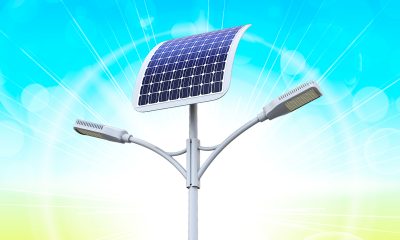What is an all-in-one solar street light
An all-in-one solar street light is an outdoor LED luminaire that integrates the light engine, solar panel, rechargeable battery and power management system into a compact, water-proof, and easy-to-install assembly. Solar street lighting systems have been around for many decades. They provides a viable solution to provide lighting in otherwise dark or inaccessible locations that are beyond the affordable reach of utility grid. However, traditional solar street lights are bulky and low-performing due to the use of cumbersome lead acid batteries and energy-hungry light sources. These systems have a short autonomy and require frequent maintenance. The costs of shipping and installing these systems can be a substantial investment. Moreover, traditional solar street lights in their purely functional design can’t blend into the landscape of many outdoor environments they serve.
A multi technology solution
All-in-one solar street lights are products of revolutionary advancements in both lighting and battery technologies. The advent of solid state lighting based on LED technology allows the load on the battery system to be drastically reduced. Low power consumption of the light source translates to reduced weight and volume of the battery system. The fact that LEDs are small semiconductor devices means light engines can be designed in an extremely compact form factor with the flexibility to fit any layout. The development of high energy density battery technology based on the lithium-ion (Li-ion) chemistry makes it possible to shrink the size of the battery bank. Moreover, lithium-ion batteries do not require regular maintenance (addition of water) as required in flooded lead acid batteries and have a much longer cycle life than VRLA batteries.
Benefits of integrated design
Significantly reduced sizes as well as the maintenance-free operation of the light assembly and battery system enable integration of components into a single product. Today solar street lights no longer have to be designed in a way that the sub-systems are separated from each other. By eliminating the need for external wiring to remote battery packs and light heads, the virtually plug-and-play, all-in-one design simplifies the installation and maintenance. The one-piece, pre-packaged system is easy to be carried and transported, which allows to cut down logistics costs. Another major benefit is that all-in-one solar street lights can be designed to fuse form and function. The ability to deliver tremendous aesthetic value facilitates the use of solar street lights in urban applications which require outdoor light fixtures to aesthetically match streetscape designs. Integrated solar street lights not only serve traditional applications with more cost-effectiveness and convenience compared with, they can also be functionally and visually integrated into all urban settings such as residential streets, pedestrian precincts and city parks.
Building blocks
An all-in-one solar street light consists of a solar module, a battery bank, a charge controller, a battery management system (BMS), an LED assembly, and other components that provide intelligent light management. All components all integrated into a rugged, water- and weather-resistant enclosure which is typically an aluminum construction with tempered glass protecting the LED module. The aluminum housing also acts as the heat sink of LED module. The heat dissipation capacity of the heat sink is scaled to lumen package. All-in-one solar street lights typically have a rectangular panel shape. However, they are available in a variety of novel designs that allow the lights to blend in seamlessly with its surroundings. These attractive designs are usually found in pedestrian scale applications. Their deform appeal offers an organic look that will easily merge into the recent urban decorating trend.
Solar panel
All-in-one solar street lights are equipped with a high performance, architecturally adaptive photovoltaic system. Conventional types of rigid solar panels are made of polycrystalline or monocrystalline silicon solar cells. More recently, flexible solar modules made of thin film solar cells are utilized to create a compelling design with a beautiful mix of geometric and artistic efforts. Monocrystalline solar panels are the best-performing products among all types of solar panels. This type of panels has an efficiency as high as 24% while the efficiency of polycrystalline solar panels is typically 14-16%. If space is limited then monocrystalline panels would be the choice. Otherwise, the cost of solar panels should be weighed against their efficiencies. Monocrystalline panels cost 30% more to produce than polycrystalline panels. Thin film solar panels currently used in off-grid products are the least efficient of all types, but they have the lowest production cost and can be fabricated on an ultra-thin wafer.
Solar charge controller
The electrical power generated by the solar module charges the battery via the solar charge controller. Charge controllers are used to control the charging and discharging of the batteries. They are of critical importance in a solar power system. Charge controllers are basically DC-DC converters which use pulse width modulation (PWM) or maximum power point tracking (MPPT) to regulate the DC power coming from the solar array. PWM controllers are most suitable for low power (specifically low current) charging applications where “boost” benefits are minimal. MPPT controllers are more expensive but outperform PWM controllers in high power systems and in colder climates. Solar charge controllers constantly monitors the state of the batteries to maximize charging efficiency while protecting them against electrical abuse events such as overload, over-charge, over-discharge and accidental short circuit.
Rechargeable battery
The battery has the biggest influence on cost, weight, volume, autonomy, and lifetime of a solar street light. As mentioned previously, the lithium-ion chemistry is favored for its overwhelming advantages over other battery chemistries such as nickel metal hydride (NiMh) and lead acid. Among all energy storage technologies currently available for off-grid applications, lithium-ion batteries have the highest charge efficiency, gravimetric and volumetric energy density, as well as the longest cycle life even when they’re deep-cycled to 80% depth of discharge (DoD). However, lithium-ion batteries suffer from significant safety concerns due to their high energy density nature and the presence of flammable organic electrolyte. These batteries are subject to thermal runaways when there are overcharging, overdischarging, external short circuit, low temperature and high rate charging conditions. Mechanical stresses and high temperature use can also lead to thermal runaways. Therefore, the electrochemical cells used in battery packs should be individually monitored and controlled by a battery management system so that they’re operated within the specific tolerance range.
Light engine
The light engine of an all-in-one solar street light may be comprised of one or more LED modules. Among all types of LED packages, the PLCC based mid-power LEDs have the highest efficacy due to the use of reflective package components. The high efficacy and low cost of these LEDs prompted their widespread use in solar systems. However, this type of LEDs is prone to thermal degradation because of their plastic construction. Their thermal performance is not as robust as high power LEDs and COB LEDs. The thermal resistance along the thermal path from the LED module to the luminaire body therefore should be as low as possible. Effective thermal management of the LED system is also important to maintain the optimal performance of the solar module and battery system. Temperature is a negative factor that affects solar panel efficiency and battery life. Care should be taken to prevent the waste heat generated by the LEDs from stressing these components.
Drive current regulation
LEDs are current driven devices, rather than voltage driven devices. This electrical characteristic allows the light source to be driven directly by the direct current (DC) electricity discharged by the battery system without using an AC-to-DC driver. The absence of AC-to-DC power conversion loss in LED-based solar lighting systems and zero wire loss due to the co-located battery contribute to the high system efficiency of LED solar lights. To improve battery autonomy, solar street lights are often designed with additional features such as dimming control, motion detection and dusk-to-dawn sensing.



















Loading...
New member
New member